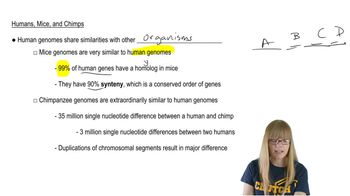Table of contents
- 1. Introduction to Genetics51m
- 2. Mendel's Laws of Inheritance3h 37m
- 3. Extensions to Mendelian Inheritance2h 41m
- 4. Genetic Mapping and Linkage2h 28m
- 5. Genetics of Bacteria and Viruses1h 21m
- 6. Chromosomal Variation1h 48m
- 7. DNA and Chromosome Structure56m
- 8. DNA Replication1h 10m
- 9. Mitosis and Meiosis1h 34m
- 10. Transcription1h 0m
- 11. Translation58m
- 12. Gene Regulation in Prokaryotes1h 19m
- 13. Gene Regulation in Eukaryotes44m
- 14. Genetic Control of Development44m
- 15. Genomes and Genomics1h 50m
- 16. Transposable Elements47m
- 17. Mutation, Repair, and Recombination1h 6m
- 18. Molecular Genetic Tools19m
- 19. Cancer Genetics29m
- 20. Quantitative Genetics1h 26m
- 21. Population Genetics50m
- 22. Evolutionary Genetics29m
15. Genomes and Genomics
Comparative Genomics
Problem 6b
Textbook Question
Annotation involves identifying genes and gene-regulatory sequences in a genome. List and describe characteristics of a genome that are hallmarks for identifying genes in an unknown sequence. What characteristics would you look for in a bacterial genome? A eukaryotic genome?
 Verified step by step guidance
Verified step by step guidance1
Identify open reading frames (ORFs) in the genome sequence, which are continuous stretches of codons that begin with a start codon (usually AUG) and end with a stop codon (UAA, UAG, or UGA). ORFs are indicative of potential protein-coding regions.
Look for promoter regions upstream of ORFs, which are sequences where RNA polymerase binds to initiate transcription. In bacterial genomes, these often include -10 and -35 consensus sequences, while eukaryotic promoters may contain TATA boxes.
Examine the genome for ribosome binding sites (RBS) in bacterial genomes, such as the Shine-Dalgarno sequence, which is located upstream of the start codon and helps recruit the ribosome for translation initiation.
Search for intron-exon boundaries in eukaryotic genomes, as eukaryotic genes often contain introns that are spliced out during mRNA processing. Look for consensus splice site sequences at the intron-exon junctions.
Identify regulatory sequences such as enhancers and silencers in eukaryotic genomes, which can be located far from the gene they regulate and influence the level of gene expression by interacting with transcription factors.
Recommended similar problem, with video answer:
 Verified Solution
Verified SolutionThis video solution was recommended by our tutors as helpful for the problem above
Video duration:
56sPlay a video:
Was this helpful?
Key Concepts
Here are the essential concepts you must grasp in order to answer the question correctly.
Gene Structure
Gene structure refers to the organization of genes within a genome, including elements such as exons, introns, promoters, and terminators. In both bacterial and eukaryotic genomes, recognizing these components is crucial for identifying functional genes. For instance, eukaryotic genes typically have introns that are spliced out, while bacterial genes are often continuous sequences without introns.
Recommended video:
Guided course

Ribosome Structure
Regulatory Sequences
Regulatory sequences are regions of DNA that control the expression of genes. In bacterial genomes, these include promoters and operators that interact with transcription factors, while in eukaryotic genomes, enhancers and silencers play a significant role. Identifying these sequences helps in understanding how genes are turned on or off in response to various signals.
Recommended video:
Guided course

Sequencing Difficulties
Genomic Context and Conservation
Genomic context refers to the surrounding sequences and the overall organization of the genome, which can provide clues about gene function. Conserved sequences across different species often indicate essential genes. In bacterial genomes, operons (clusters of genes transcribed together) are common, while in eukaryotic genomes, synteny (conserved gene order) can help identify homologous genes and their functions.
Recommended video:
Guided course

Genomics Overview
Related Videos
Related Practice





